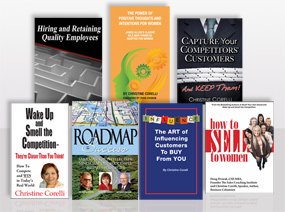Stressed Out – Who ME?
One of the biggest challenges for business professionals today is workplace stress. It’s not hard to figure out the reasons why stress is rampant in the workplace. Downsizing, reorganization, rapid change, tough customers, fierce competition, and having to do more with less have created stressful environments worldwide. This holds true regardless of what business you’re in.If not properly addressed, the results can be low morale, decreased productivity, lack of teamwork, and downright cranky people. No company can afford this type of environment, and yet it exists in many organizations.Telling employees to take “mental breaks,” and providing seminars on stress management and life-balance can help employees to learn tips on how manage their stress levels, but this is not enough. Today, executives and managers need new approaches to reduce the levels of employee stress. Providing a positive work environment and an innovative company culture are essential. Below are methods to help you to create a positive work environment and reduce workplace stress.
1. Reduce Workplace Stress Caused By “High-Demand-Low Control.”
Most workplace settings are characterized by “high-demand and low control.” If employees have too much to do for too long, with constant deadlines (high demand), and too little influence over the day-to-day organization of their own work (low control), stress is the result. To help alleviate employees’ stress levels, increase their control over means of production and give them a say in how they meet demands. Ask for their ideas on how to streamline operations, procedures, and processes and handle their own work flow. This can go a long way in reducing their stress levels. Be sure the workload is suitable to employees’ abilities and resources; avoid unrealistic deadlines. In addition, make sure there is an equal distribution of workload.Soliciting and using employee input on decisions affecting space, design of workstations, lighting, heating, cooling, general efficiency and safety can help them feel a sense of control. For example, the YMCA headquarters in downtown Chicago just remodeled their three floor workplace. To optimize employee productivity and increase morale, they allowed their employees to design their own work-spaces or “cubes” in a manner that suits their personal work style. Each looks different, and is suited to the way they can work most productively.Give workers opportunities to participate in decisions that affect their jobs. Consult employees about scheduling and work rules as well. Better yet, throw away the rule book. Instead, use the values of honesty, integrity, teamwork, excellence, customer-focus, respect, safety and have employees create “guiding principles” on how everyone will treat each other.
For employees who have a long commute, allow them to work from home one or two days a week if that will help them to meet their deadlines with less stress and give them more of a feeling of control.
2. Eliminate “High-Effort-Low Reward”
Another factor involves “high effort and low reward”. If your employees must consistently expend high amounts of mental and/or physical energy (high effort), and feel they receive inadequate acknowledgment of their efforts they feel that no matter how hard they work, they will never receive any type of reward. Never let a week go by without telling an employee how much you appreciate their hard work, but also give them small and meaningful rewards for a job well done. Reward individuals with a nice note and gift card. Reward teams with a cook-out or tickets to a movie theater.
3. Don’t breathe down their necks.
If employees are competent and well- trained, leave their job to them. Avoid micromanaging. Constant monitoring only hinders performance. Instead, ask how a project is coming along, and whether they need any help.
4. Display dynamic leadership and Insist on a Zero-Tolerance for Bad Bosses” policy in your company.
One of the greatest causes of stress in the workplace is working for a boss who is unappreciative, unavailable, and close-minded. Make sure all of your leaders receive training on how to display dynamic leadership, and that they all lead in the same way. Make sure you are absolutely the best boss you can be!
5. Put fun back into the workplace.
Fun in the workplace? What a novel idea. Business is serious, but the best way to help employees manage stress is to implement simple ways to alleviate stress and help avoid job-burnout. Appoint an Activities Director to arrange for lunchtime or after work activities. Once a month, do a team-building activity. Eliminate boring meetings. Weather permitting, have a meeting in the parking lot instead of a conference room. Draw for a gift card at your meetings. Start each meeting with “What’s happening that’s good?” Have people talk about it. Put a pool table in the lunchroom or back area. Get creative. Doing your absolute best to alleviate workplace stress is not only the interests of employees. It’s also simply smart business. Make your place of business a great place to come to work each day.
Need a great speaker on this topic? Click Here!


Micromanaging is indeed a big No-no in my book. It kills employee initiative to want to learn things and grow on their own.
Great leaders enable people through training. Once both employee and leader are confident, the leader should let them take the ball and run with it. Thanks for your comment Ian.